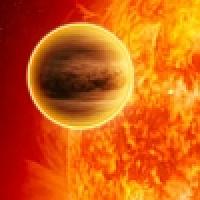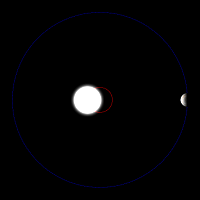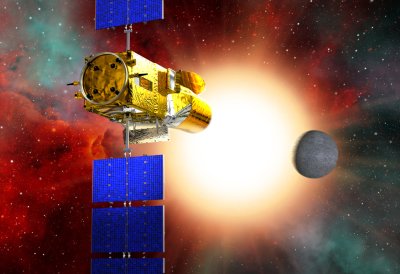
Hunting for life in alien worlds

Where are they?
Two of the most fundamental questions asked by people, and as yet still unanswered by science, are how life emerged on the Earth, and whether we are alone in the cosmos: does life exist in extraterrestrial locations as well? These deeply important questions form the core of a new kind of science, one that recently has been rapidly gathering momentum. Astrobiology is supported by a flood of new information from studies on the origins of terrestrial life, and our deep-space probes and telescopes exploring the Universe around us. The science incorporates everything from understanding the survival of life in the most extreme environments on Earth and looking for the earliest evidence of cells in the ancient rocks of our planet, to exploring the alien worlds of our solar system to determine if they have ever provided an environment suitable for life of their own.
Within our own solar system, astrobiologists consider several possible habitats for extraterrestrial life. These include our next-door neighbour planet Mars (if not now, then at least earlier in its history), as well as Jupiter's moon Europa which is known to have a global ocean of water beneath its icy surface, and perhaps the giant hydrocarbon-soaked moon of Saturn, Titan. Only one of these locations, the surface of Mars, has ever been tested for life. This was back in the 1970s with the twin Viking robots, but the results of their biological detection instruments were ambiguous to say the least. My own research focuses on the surface of Mars and the effects of the radiation from space on any martian life or evidence of its ancient existence. We will be specifically looking for life on Mars again in the next few years with NASA's Mars Science Laboratory and the European Space Agency's ExoMars rover (which I'm working on).
Another recent development in astrobiology has been the ability to detect planets in other solar systems: new worlds orbiting distant stars in the night sky. Over 340 of these so-called extrasolar planets, or exoplanets, have been discovered so far (as of May 2009), and we are now on the brink of being able to detect a terrestrial planet orbiting a sun-like star: a second Earth.
In this article, we'll look at two aspects of the astrobiology of extrasolar planets: how to spot them, and how to check for signs of life across the gulf of deep space.
Planetary waltzes
One method for detecting distant exoplanets, far too faint to see directly with current telescopes, is to look for their effect on the star they're orbiting. We're taught at school that planets like the Earth orbit around a star like the Sun. Well, this isn't strictly true. The planet and the star both orbit around a common centre of mass between them.
Imagine two friends facing each other and holding hands with straight arms. If they now start whirling around each other they both turn around a point mid-way between the two of them — where their hands are linked. This point is called their centre of mass. But if one of the partners were much heavier, say a father twirling round his daughter, then the centre of mass that they both spin around would be pulled closer to him and he would move much less, as the girl spins around him.

A planet and a star both orbit around the centre of mass of their system. Animation courtesy Rnt20.
The same is true of stars and planets. Because a star is so much more massive than a planet (the Sun, for example, is over a thousand times heavier than Jupiter, the largest planet in our solar system) the centre of mass that they both orbit around is much closer to the star. In fact, the centre of mass for the Sun-Jupiter system is actually inside the Sun. This means that as a planet orbits around its star, the star itself is also wobbling around in a circle due to the gravity of the planet. These star-wobbles are incredibly subtle, but luckily astronomers have worked out a really clever way of spotting them, using the Doppler shift of the starlight.
The Doppler effect describes how the frequency of waves is compressed as their source moves towards you, and then stretched out as the source passes you and moves away. You'll be familiar with this effect from hearing the noisy siren of an ambulance as it races past you. The siren sound has a higher pitch as the ambulance approaches, and then there is a sudden drop in the pitch as the ambulance overtakes you. The same happens with the light emitted by a star as it wobbles around an orbiting planet. Sometimes the star is being tugged slightly towards the Earth and its light appears shifted to the blue end of the spectrum by this motion, and then later the star is being pulled away again and the light is shifted to the red end of the spectrum. So an orbiting planet produces a cyclic Doppler shift in the starlight which astronomers can measure and so infer the presence of the planet.
Noisy stars
Simply detecting the periodic stretching and squashing of starlight is only the fist step. The degree of Doppler shift depends on how fast the star is moving towards, or away from, the Earth and so astronomers can calculate the speed of the star's wobble, called the radial velocity. If the planet orbits its sun in a perfect circle then the star's radial velocity varies as a sine curve: the positive peaks of the sine curve correspond to the star moving directly towards us, the negative peaks of the sine curve to the star moving away from us along our line of sight, and the other points of the sine wave correspond to the star being in between the two extremes of its wobble.
But things are rarely that simple! The Earth's orbit around the Sun is actually a pretty good approximation of a circle, whereas those of many of the extrasolar planets discovered so far are pretty stretched out in one direction into an elliptical path. This means that the strength of the planet's gravitational tug on its star changes during the course of each orbit, which distorts the symmetry of the sine curve of the star's radial velocity as it wobbles back and forth.
To make things even more complicated, planets aren't thought to form as an only-child around a star, but as siblings in a whole family of orbiting planets. This means that the radial velocity graph of a star with multiple planets can vary in a very complex pattern. There is often also a great deal of noise in the recorded data, particularly if your telescope is beneath the churning weather of the Earth's atmosphere, and the surface of stars themselves are constantly boiling and vibrating like the skin of a drum.
A very fitting curve
So detecting alien planets around distant stars is a far from routine effort, and a lot of statistical mathematics must be used to pull out the signal of the orbiting planet from the noise in the measurements of the starlight. One particular problem is finding the best solution to fit the measurements of the star's radial velocity. "The task of estimating the parameters of a planet's orbit — the orbital period (the length of the planet's year), for example — is very tricky," explains Sreekumar Balan, an astrophysicist at the University of Cambridge. Any number of different sine curves could be fitted to the data, with slightly different amplitudes, or periods, or set to be more or less symmetrical (depending on how elliptical the planet's orbit is). "This process gets even more complicated if you try to fit the data with overlapping sine curves of more than one planet," says Balan.

The radial velocity measurements recorded from a star called HD187085 (data points with vertical error bars) and two different orbital solutions calculated by the ExoFit statistical software (solid and dashed sinusoidal curves). Image courtesy Sreekumar Balan and Ofer Lahav, 2009, from a paper to appear in MNRAS.
So how do you know which of this infinitely varied class of possible curves fits the data as closely as possible — which is the most probable or optimum orbit of a new planet? Sreekumar Balan and Ofer Lahav, at University College London, have designed computer software, called ExoFit, to help with just this conundrum. "It is based on Bayesian parameter estimation," explains Balan. Imagine a graph with orbital period and eccentricity (how elliptical the orbit is) along the two axes. Each (x,y) point on this graph corresponds to a particular possible solution to the orbit of the new planet. "The computer takes a random walk through this parameter space and for each possible solution uses a statistical method called Bayes' theorem to work out how probable it is." From this, Balan and Lahav can find which particular combination of period and eccentricity gives the best orbit of the planet to fit the radial velocity measurements of the star. The diagram on the left shows the radial velocity measurements recorded from a star called HD187085 (data points with vertical error bars) and two different orbital solutions calculated by the ExoFit statistical software (solid and dashed sinusoidal curves).
Winking suns
This radial velocity technique has discovered the vast majority of alien solar systems that we now know to exist. But detecting a small rocky planet orbiting within the habitable zone of its star — the sort of world we think would give life its best chance — is currently beyond the capability of the radial velocity technique.

An artist's impression of the COROT satellite looking at a star with a planet passing in front of it. Image: CNES 2006 - D. Ducros.
Another technique, called the transit method, looks for the slight dimming in the brightness of a star as a planet passes in between it and the Earth. This method is likely to be the first to spot a truly Earth-like planet, and perhaps even within the next few years. In December 2006 France launched a space telescope called COROT that ought to be able to spot Earth-sized planets, and just this March NASA launched a much larger space telescope called Kepler. Kepler has the most sensitive digital camera ever sent into deep space and will stare at the same patch of starry sky for over three years, carefully recording any variations in the brightness of more than 100,000 suns that might be planetary transits. Depending on how common Earth-like planets are in our galaxy, Kepler could discover up to ten or more during its mission.
Water on the rocks
The best results come about if you can combine both radial velocity and transit techniques. The Doppler shift tells you the mass of the planet, the amount of star-dimming during the transit tells you the diameter of the planet, and by combining this information you can work out the density of the new world. Calculating the density is very important because it will tell us if the planet is a small rocky body like Earth, or is perhaps a gassy world shrouded in a thick atmosphere that probably wouldn't provide an environment suitable for life. Once the orbit of the new world has been determined, and taking into account the kind of star it orbits, it is also possible to work out the likely temperature on its surface, and so whether water would be liquid or not. Ultimately, the thing that astrobiologists are aching to discover is a wet rock orbiting a sun-like star.
Chemistry of alien atmospheres
Astronomers can go even further than working out the probable climate on a planet. If they are able to collect light that has come from the planet, either sunlight reflecting off its surface or the infrared glow of the warm planet itself, it is possible to pull off something very exciting indeed. By studying light from the planet it is possible to actually read the chemical make-up of its atmosphere, from all the way across the gulf of interstellar space without even needing to leave Earth.

This is one of the telescopes that will take part in ESA's Darwin mission to analyse the atmospheres of possible Earth-like planets. Image courtesy ESA. Illustration by Medialab.
This trick comes down to a technique called spectroscopy. If you take sunlight and spread it out into a spectrum you'll reveal all the colours of the rainbow — Isaac Newton first managed this with a glass prism, but nowadays we use very precise diffraction gratings. But sunlight isn't actually a smooth continuation of colours; it has dark gaps missing where something has absorbed light of that particular colour, or wavelength. Different atoms in the sun absorb light at specific wavelengths, and in fact the element helium was first discovered by the gap its absorption left in the spectrum of sunlight (its name comes from the Greek word for sun, helios). If you look at longer wavelengths, into the infrared part of the spectrum, the absorption bands are from particular molecules. So all you need to do to read the chemistry of an alien world is split the light coming from it into a spectrum, and look for wavelengths that have been absorbed by its atmosphere.
Signs of life
Carbon dioxide leaves a very obvious dip in the infrared spectrum, and tells you that the new world does indeed have an atmosphere with a greenhouse effect acting as a planetary blanket to keep the planet cosy and warm. Water vapour also leaves its mark in the spectrum and would confirm a wet world.

The Earth's atmosphere contains ozone, protecting it from harmful UV rays. Image courtesy NASA.
Ideally, we'd be able to analyse the spectrum of a distant planet by imaging it directly. For example, the Hubble Space Telescope can easily photograph the other planets in our own solar system, isolating only the light coming from the planet. But to do this for an Earth-like planet orbiting another star light years away is far beyond our current state-of-the-art telescopes. We would need an array of telescopes spread out over hundreds of metres in space, and a mission like this won't be launched until at least 2015. Astronomers have, however, already been able to detect different molecules in the atmospheres of a few extrasolar planets.
A steamy world

An artist's impression of the exoplanet HD 189733b transiting its sun. Astronomers have detected both water vapour and methane in its atmosphere. Image: ESA - C.Carreau.
Planets which transit their sun from our point of view periodically pass in front of the star, and then half an orbit later slide behind it and are obscured. If you record a spectrum of the starlight at these two times you essentially create a before and after snapshot, firstly including light that has streamed through the planet's atmosphere and secondly containing only starlight when the planet is hidden. Subtracting one from the other removes the over-powering starlight and leaves only the spectrum of light from the planet itself. Using this very clever trick astronomers have detected both water vapour and methane in the atmosphere of the same planet, HD 189733b. This planet, however, is larger than the gas giant Jupiter and orbits so tightly around its star that its whole year lasts only two Earth-days. HD 189733b receives such a roasting from its sun that the temperature of its atmosphere is estimated to be over 900°C, and so this is certainly not the sort of planet we think could support life.
The discovery and characterisation of worlds beyond our solar system, or exoplanetology as the research has come to be known, has certainly come a long way in the fourteen years since the first planet was discovered orbiting another star. But this is just the beginning, and there is every chance that the first Earth-like extrasolar planet will be announced in the next few years. After this revolutionary discovery the long, hard slog to get to know this planet and read the chemical make-up of its atmosphere for signs of life will begin.
About the author


Lewis Dartnell is an astrobiology researcher based at University College London, focussing on the possibility of microbial life surviving on the surface of Mars. He has recently published a popular book on the science of astrobiology, Life in the Universe: A Beginner's Guide. You can read more about his research and popular science writing at his website. Please contact Lewis if you would like him to give a talk about the search for life beyond Earth at a science festival or school.